

NOW YOU SEE IT



| ||
Front Game Rules (1974-5 version) | ||
| At the beginning of the series, a total of five players, one of whom was a returning champion, competed. In the first round of the game, the teams were shown a board of four rows, with 14 letters in each row. Two challengers faced the board while the other two - their teammates - had their back to the board. Host Narz read the clue to a word hidden on the board, and the players facing the board attempted to buzz in and give the row in which the answer resided. If correct, his/her teammate spun around and tried to locate the word. If successful, the team won a number of points equalling the row where the word was found plus the position of the first letter. (For example, a word in row 3, position 7 would be worth 10 points). Players switched positions halfway and were given a new board; the team with the highest score advanced to the semifinals. | 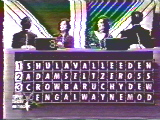
| |
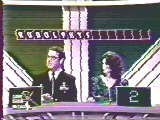
| In the semifinals, the two teammates competed against each other for the right to face the champion. Narz would read a clue and the answer would spell out, one letter at a time. Obviously, the last letter was not given. The first person to get 4 words correct made it to the finals. The finals was played similarly to the first round, with the same player guessing the row and the word. The player with the most points at the end of that round made it to the Solo round. | |
| The format underwent several changes during its run, and ended up pitting two challengers against each other in the same format as the semifinal round, whose winner would face the champ in the finals. Gameplay was the same in the finals, except that the first to score 100 points won. | 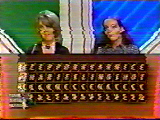
| |
Front Game Rules (1989 version) | ||

| The first round began with two challengers. Both players were shown a 4x14 board of letters like above. Host Henry read a clue to the answer, and a clock then began ticking down the value of the answer from a maximum of 100 points until one player buzzed in. If the timer reached 10 points, Henry would then spot the row number to the players. Two boards were played, with point values doubling when time ran short. The first to score 1000 points went on to the championship round. | |
| In the championship round, the winning challenger and the returning champion were shown a series of boards, each containing six words that fit a category. The category was read, and the first player to find a word then had 20 seconds to try and locate the other five words. If successful, the player won that board, otherwise, his/her opponent could steal the board by finding one more answer in 5 seconds (after having been unable to see the board while the first player searched). The first board was worth $200, with each board increasing in value by $100. The first player to score $1000 got to keep the money and went to the Solo round. | 
| |
End Game Rules (Both versions) - "Solo Round" | ||
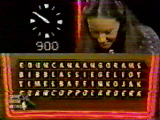
| In the end game, the player was shown yet another board, and had 60 seconds to find ten answers, circling each answer with a light pen. The contestant won $100 for each word circled, and won $5000 plus $1000 for each previously unsuccessful round in the '70s version, or $5000 plus $5000 for each show it wasn't won in the '89 version. | 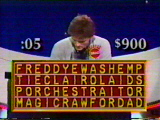
|
An admirable attempt at translating word searches into the field of game shows. In both runs, the simplification of the board to only have words read horizontally made the game easier for the folks at home to play along. The 1974 run, however, was plagued with constant format changes and a scoring structure that made absolutely no sense (why would one word be worth 5 points and the next worth 12?) The 1989 run had a significantly better format, and a marvelous set. Unfortunately, Chuck Henry looked like he regretted his signing the contract about 3 minutes into the show, and his hosting made that apparent.
Gameplay: 1 pt.
Host: 3 pts.
Presentation: 2 pts.
Execution: 0 pts.
Total Score: 6 pts.
Gameplay: 3 pts.
Host: 1 pts.
Presentation: 2 pts.
Execution: 2 pts.
Total Score: 8 pts.